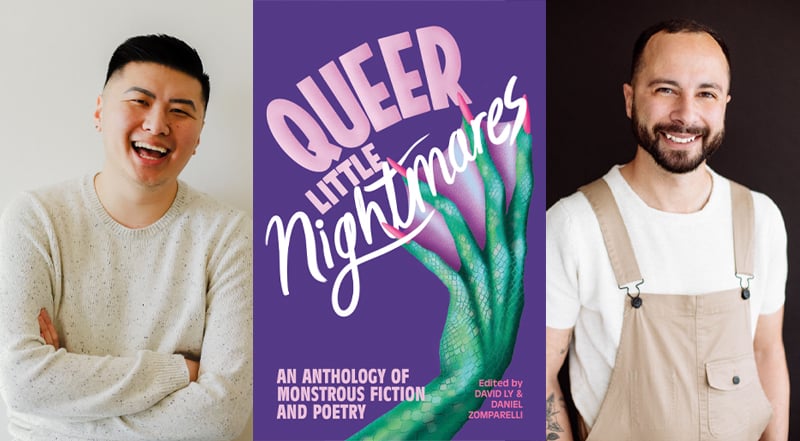Monsters are supposed to be scary, right? At the hands of a cadre of talented LGBTQ+ authors in a groundbreaking new anthology, they are also sad, vulnerable, needy – and even funny. In Queer Little Nightmares: An Anthology of Monstrous Fiction and Poetry (out now from Arsenal Pulp Press), a diverse set of contributors – including Kai Cheng Thom, Amber Dawn, jaye simpson, and Hiromi Goto – upend genre conventions, mixing horror with elements of speculative fiction, romance, and pulp fiction. Amid all the chills and thrills, these queer and trans writers ask pointed questions about the nature of fear, the power of transformation, and what it means to be persecuted for being different. Q&Q spoke with editors David Ly and Daniel Zomparelli about the allure of monstrous characters, balancing fiction with poetry, and why Vancouver is so creepy.
Why is there such an enduring affinity between the LGBTQ+ community and “monsters,” or the horror genre more generally?
David Ly: We’re drawn to the power we find in these monsters. Though they’re frightening, there’s something awe-inspiring and admirable in the strength and influence they have. Despite being feared for what they are, they continue to be themselves! Historically, queer people have been pushed to the margins of society (much like monsters) so we feel a connection to them – where others may have seen something fearful and strange, we draw strength.
Daniel Zomparelli: There’s something about terrifying straight people with high drama that feels very fun. It’s why I’m drawn to Freddy Krueger and Pennywise. They have the hearts (or lack thereof) of drag queens, with dramatic reveals and perfect one-liners.
Queer Little Nightmares features as many poems as short stories. Why was it important to you to give poetry such prominence?
DZ: My first love is poetry, so I always want to see that in any anthology. I also like the freedom poetry offers to discuss pop-culture monsters in a very personal way, without fear of copyright infringements.
DL: I wanted the poems to be of interest to non-poetry readers. Including poetry was an opportunity to showcase how the form could lend itself -to telling a captivating narrative just as well as the short story.
Multiple stories in the book deal with issues of racism in queer communities. For instance, jaye simpson’s story “#WWMD” includes an exploration of the violence and exclusion faced by Indigenous trans women, and Eddy Boudel Tan’s “Strange Case” conveys the pervasiveness of anti-Asian racism among white gay men online. Do the themes of the horror genre have a particular resonance for BIPOC queer and trans people?
DL: Of course. Being viewed as the “other” or “less than” or scary or misunderstood are cornerstones of the horror genre, where monsters are personifications of these sentiments. The inception of this anthology came from how we, as editors, could see how facets of the horror genre were representative of the experiences of BIPOC queer and trans people, in that within queer communities there is still exclusion and othering. In a way, the queer little nightmares in this anthology aren’t so much “nightmares,” but the realities we face on a day-to-day basis.
So many of the stories are set in Vancouver. What makes it an ideal setting for scary or post-apocalyptic fiction?
DZ: Having grown up in Vancouver, it feels like two different cities. One is full of people creating community and care, and the other one is a real estate mausoleum of sterilized condos. I think the dichotomy of those two things creates an interesting setting for the end times.
DL: Since I am from the Lower Mainland, having scary fiction set in Vancouver resonated with me because it felt all the more real. I can clearly visualize the places referred to in the stories, or recall experiences in similar spaces, and that makes the fear all the more real – also, Vancouver is already so weird and terrifying.
Over the past 20 years, there have been quite a number of LGBTQ+ anthologies on similar themes. What sets Queer Little Nightmares apart?
DL: Our anthology really puts the monsters on centre stage. Whereas other anthologies were compiled with essays or other reflective pieces on how monsters or horror as a genre have shaped queer identities, Queer Little Nightmares is really just about the fun that queer writers can have with the genre and monsters. The poets and writers celebrate monsters for what they are, and in doing so speak volumes to how queer people are celebrated. Daniel and I have so much fun watching scary movies and talking about monsters, so we wanted the collection to embody this.
What is one thing about the book that you think may surprise some readers?
DL: Just the sheer diversity of how monsters and the genre resonate with different writers. Reading through you really get a sense of how a monster is important to a poet, or how it can lend itself well to a re-imagining within a short story. I’m very excited for people to read these clever approaches, and how familiar monsters are seen in a contemporary context.
DZ: I think readers will be surprised at the different styles. I hope those who are not necessarily horror fans will pick this up, because many of these poems and stories have a lot of fun with the genre.
This interview has been edited and condensed.
David Ly: Joy Gyamfi; Daniel Zomparell: VictoriaTakesPhotos

 Contact us via email
Contact us via email

